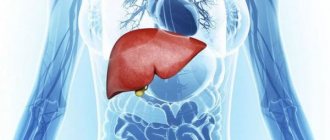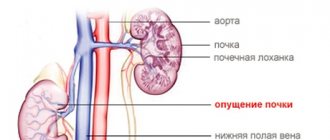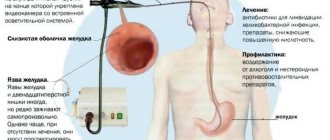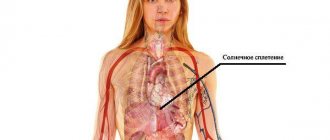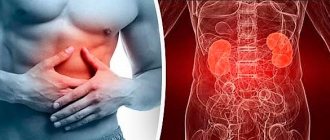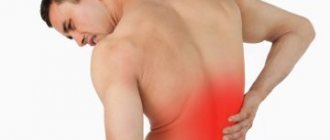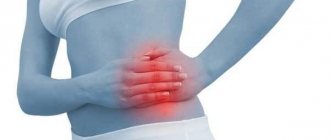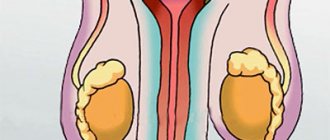Types of side pain
Pain in the right side under the ribs manifests itself as a response to the presence of inflammation in the liver, kidneys, gall bladder, and intestines. They are also capable of causing unpleasant sensations of injury. The pain varies from barely noticeable and aching to severe, cutting, unbearable. It can be localized or spread to the entire side, stomach and ribs, or even extend to the shoulder. There are the following types:
- Acute pain in the right side “screams” about colic (liver).
- Dull pain in the right side – ailments (chronic) in the abdominal area.
- Stitching means there is inflammation.
- A nagging pain in the right side hints at chronic hepatitis.
- Aching pain in the right side is excruciating if there is constant inflammation of the mucous membrane of the large intestine and gall bladder.
Possible causes of pain
The lower part of the abdomen on the right is called the right iliac region. Anatomically, it is located between the lower rib and the pelvic bones. There is a cecum, an ileum, and a vermiform appendix.
If the cecum is not full, then in front it is closed by loops of the small intestine, otherwise it occupies the entire area. Also nearby the woman is the fallopian tube and ureter. Discomfort in this area is often felt with pathologies of the gastrointestinal tract, but since there are organs of the urinary and reproductive systems nearby, the reason is not so obvious.
Pain in the lower abdomen on the right in women is felt as a result of:
- appendicitis;
- inflammation of tissue and lymph nodes;
- perforation of the ulcer;
- Crohn's disease;
- intestinal dysbiosis;
- torsion of the sigmoid colon;
- osteochondrosis;
- gynecological disorders;
- purulent inflammation of the iliopsoas muscle;
- helminthic infestation;
- urolithiasis;
- tumors of the ovary, intestines;
- femoral hernia.
https://youtu.be/kRq1PRP7tk4
Why does my right side hurt under my ribs?
Cutting and tingling on the side is a symptom of a large number of different diseases, but invariably represents a signal of some serious illness or injury. Painful discharges piercing the back indicate troubles with the liver. Among these, toxic damage to this organ due to abuse of fatty or hot foods and alcohol should be listed. Smoking is no less destructive to the liver.
Malfunction of the gallbladder is also a source of painful manifestations. If it hurts on the right side under the rib, you may think that the pancreas is “faulty”. Belonging to the endocrine system, it is responsible for the production of insulin. If severe sweating, vomiting, and nausea are added, the possibility of pancreatitis should be considered. It may be caused by injuries, consequences of surgery, or excessive amounts of alcohol. Painful sensations can also come from an inflamed appendix.
- How to restore metabolism, speed up metabolism
- How to recognize an invisible person in Odnoklassniki - which of the guests visited
- How to print text from a computer to a printer
Pain in the right hypochondrium anteriorly
What does it signal? With liver diseases, a person may experience prolonged attacks of bursting dull pain and tingling. Different types of hepatitis - toxic and alcoholic - cause vomiting, heartburn, loss of appetite, weakness, decreased performance, and can burn on the side. Liver cirrhosis cannot be ruled out. The formation of liver cysts also leads to painful manifestations: they block the bile and blood ducts, which results in a feeling of heaviness due to the enlargement of the affected organ.
Congestive heart failure causes problems with circulation throughout the body. Because of this, the liver enlarges and swelling occurs. There is also a so-called abdominal myocardial infarction, in which painful impulses will penetrate under the ribs on the right. Possible distension of the colon. With increased gas formation and intestinal problems such as diarrhea, the pain will be sudden and very severe. Severe, painful cramps may be a reaction to colitis.
Pain in the right side behind the ribs
Often such painful sensations on the side and behind occur as a consequence of injuries, with abnormalities in the functioning of the inferior vena cava, liver, or kidneys. Stones and sand can move down the ureter, causing the painful area to widen. A child often experiences pain symptoms if he has inflammation of the kidneys of an immune nature. Other causes of trouble may be pyelonephritis, necrosis of the renal papillae, bruised ribs, oncology, intercostal neuralgia, herpes zoster affecting the nerve.
- What do Nise tablets help with?
- Ambroxol - instructions for use for children and adults
- Pain in the lower abdomen in men: diseases of the genitourinary system
When inhaling, the right side hurts under the rib.
If the pain is unbearable when you breathe, this may indicate cholecystitis, the onset of pneumonia or peritonitis. During the first disease, bile, which does not enter the intestine, accumulates inside the biliary tract, stretching the membrane. It begins to bake, once on the mucous membrane, because of the caustic salt composition. This makes the pain stronger and the temperature rises. Pleurisy can cause stabbing pain that intensifies when there is a cough or inhalation.
What can hurt in the right side under the ribs on the side
Pregnant women may experience pain on the side, if the enlarged uterus puts pressure on the kidneys, the overloaded liver - the ureter will be under attack. During pregnancy, the intestines can change their position, the appendix sometimes moves, inflammatory processes are possible - all this requires immediate consultation with a gynecologist. Sharp and piercing pain in the right side in men can occur after physical activity, even such as walking.
Soreness in the right side of the abdomen and liver disease
Most often, pain is associated with hepatitis, a viral disease that affects hepatocytes. Cirrhosis and fatty degeneration are also accompanied by pain. In addition, with liver damage, there are some other symptoms that you need to pay attention to - nausea, vomiting, loss of appetite, digestive disorders, fatigue, drowsiness, decreased performance. As the disease progresses, a characteristic yellowing of the skin and sclera of the eyes appears. In such cases, the help of a doctor is simply necessary.
Which specialist should I contact?
If the pain in the right side under the ribs has become permanent, then you should consult a therapist. After a general examination and tests, he will decide which specialist the patient needs. If the pain is severe, you should immediately call an ambulance, while avoiding taking painkillers so as not to disturb the clinical picture. Planners may include:
- surgeon;
- infectious disease specialist;
- gynecologist;
- gastroenterologist;
- cardiologist;
- traumatologist;
- neurologist;
- endocrinologist
In which organs can pain occur?
Pain sensations arising on the right side are in rare cases considered as a physiological phenomenon. Typically, the discomfort that appears indicates the development of serious pathologies.
From the liver
If a person has a painful focus in this organ, it means that he has developed inflammation, or mechanical damage to the organ has occurred:
- With the development of hepatitis, which has a viral etiology, pain occurs. Most often, people encounter pathology of group “A”. Group B hepatitis primarily affects people with drug addiction. After infection, this category of patients begins to actively spread the disease among their surroundings. Group C hepatitis is transmitted through blood, and infection often occurs in medical institutions.
- Long-term use of certain types of medications and toxic effects can provoke pain in the liver. In this case, patients are diagnosed with a “toxic form of hepatitis.”
- Excessive consumption of alcoholic beverages leads to the development of the “alcoholic form of hepatitis.”
- Pain syndrome in the liver can develop against the background of heart failure, when the muscle of the organ stops pumping blood normally.
What to do and how to eliminate discomfort
To reduce pain, it is sometimes appropriate to take the drug No-shpa. Painkillers will prevent specialists from establishing an accurate picture of what is happening in the body and making a correct diagnosis. A hot heating pad will not help relieve pain, and may even cause harm, but cold will be the right solution. It would be appropriate to eat normal food: your diet should contain less fatty, spicy, fried, spices, smoked foods, canned food, sweets and alcohol. If the pain takes you by surprise, then to relieve it you need to sit comfortably and relax. It is important to avoid physical activity.
When should you see a doctor immediately?
You should not hesitate to seek medical help in such situations.:
- in addition to painful sensations, there is increased vomiting and diarrhea;
- the temperature column has exceeded 38 degrees and is creeping further;
- from acute pain the person is about to lose consciousness.
You should call a doctor because many diseases that cause pain require surgery and can be fatal. You cannot endure painful attacks.
If the pain has subsided, it is still wise to visit a doctor. He will prescribe a list of tests and examinations, or refer you to another specialist:
- gastroenterologist;
- surgeon;
- cardiologist;
- to a urologist.
Having conscientiously followed all the doctor’s recommendations and felt better, you should pay attention to prevention. It is advisable to prevent repeated manifestations of the disease.
side disease pain treatment
Carrying out diagnostics
If pain occurs in the right hypochondrium, even if it is periodic, you should definitely contact a pediatrician or therapist, who will then refer you to specialized specialists. Diagnostics must be comprehensive so that it is possible to correctly determine which disease provoked the disorder. Diagnostics includes:
- familiarization with the medical history to determine the provoking factor;
- collection and analysis of anamnesis;
- a thorough physical examination of the patient;
- abdominal percussion and palpation;
- assessment of skin condition;
- measurement of pressure, temperature;
- detailed survey of the patient.
A survey of the patient is required for the doctor to obtain the required information regarding the existing symptoms, which may indicate the cause of the pain. After an initial diagnosis aimed at determining the condition that provoked the onset of pain, studies such as:
- urine and blood analysis;
- study of feces;
- liver tests;
- serological tests and PCR;
- ultrasonography of the peritoneum;
- radiography;
- endoscopic examination;
- tomography.
Only after carefully studying the results of diagnostic measures, the doctor selects a treatment method.
